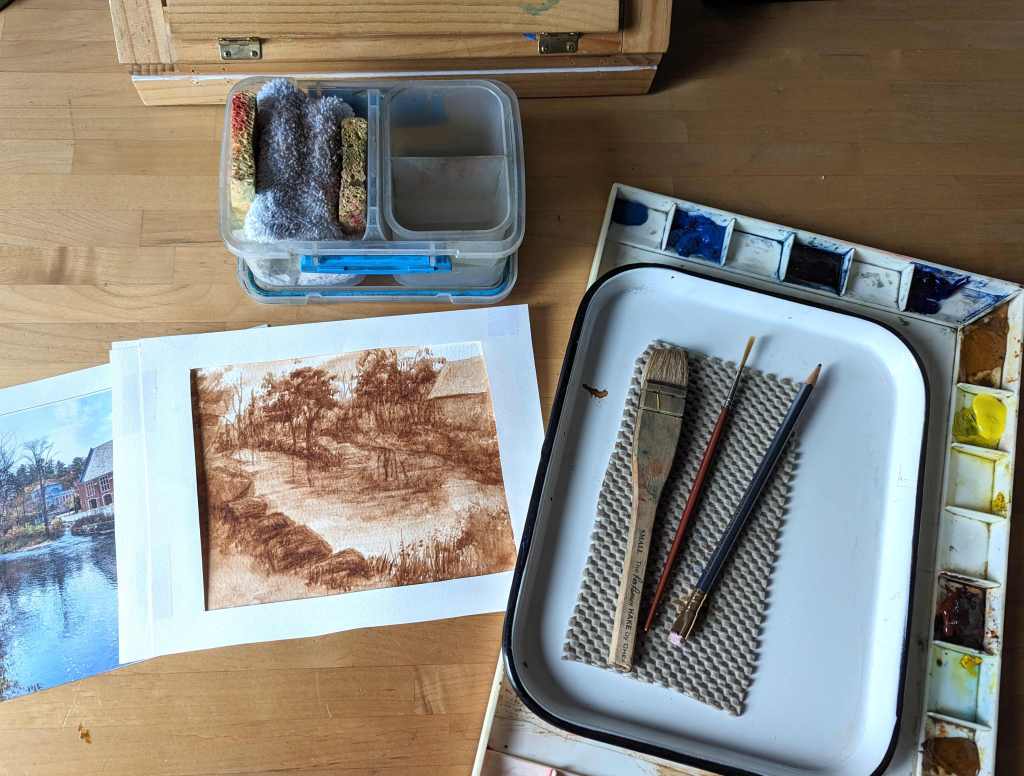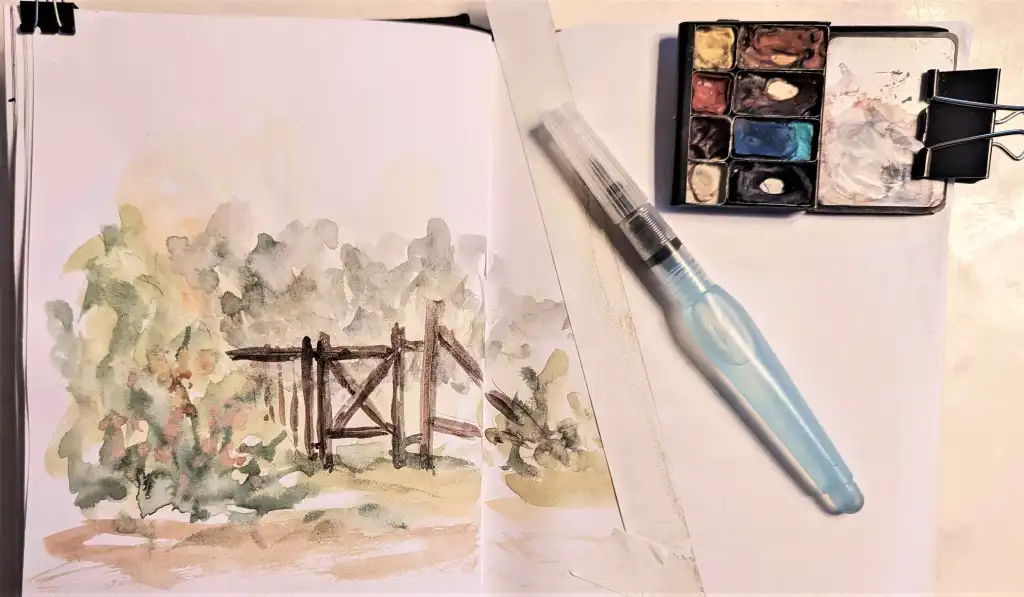(Note: This isn’t a quick read, but it’s well worth your time.)
Marc Taro Holmes gave me my first glimpse of this connection between art and climate change when he published his seminal work, “Apocalypse Variations” in 2019. The art in this book is nothing like his previous loose line-and-watercolor work.
“Apocalypse Variations” touched my soul. The artwork is fluid, dark, and ominous. The text is compelling.
“I’ve been a plein air painter for most of my twenty-five years as a working artist. Painting on location is tremendously effective training. Enough practice translating light and space writes new pathways in the brain. The ability to see, understand and simplify…. These paintings turn out to depict dark, hopeless expectations which can’t be discussed openly in polite society. I feel that honest despair about the future is seen as weakness. People don’t want to hear it… I’m talking about the state of the environment, the climate, just everything. It’s something, as a landscape painter, you can’t avoid thinking about.” – Marc Taro Holmes
His passion, his sense of urgency, helped spur me on to create a fresh approach to teaching the “why bother?” of watercolor. That inspiration led me to write “Look at That!“
A few months after publishing my first book, I stumbled across this brilliant work by HRH, The Prince of Wales (now King Charles) entitled “Harmony,” published in 2010.
I purchased the audio version first; soon after that I also bought the eBook version so I could read along while listening to the impassioned inflections in his familar voice.
You hear the clarity, the wisdom, and the frustration in his voice. He points out that worldwide collaboration is the only possible environmental solution. You might think a lifelong visionary environmentalist who was also the future king of England might have the power to initiate global changes. But no, he too has had to “think globally, work locally.” Collaboration requires community consensus.
A month after reading and listening to this book, I came across the captivating documentary “Royal Paintbox” (released in 2014).
I recalled the message Marc Taro Holmes had pointed out two years prior:
When you sketch outdoors in the wild,
you fall more deeply in love with the wild.
When I spend time carefully observing (and sketching) my surroundings, I create a new relationship with whatever I am looking at. Years later, when I walk past that garden or that house or that stone wall, I smile inside because I recognize our secret. At first I thought to myself, “That’s my garden…” but that’s not quite accurate. I’m acknowledging a relationship, not an ownership. It’s more like recognizing, “That garden is a part of me now.”
Those of you who sketch outdoors know exactly what I mean.
To recap so far:
I began regular plein air sketching in January 2013.
I began teaching sketching for the joy of seeing in October 2017.
I read “Apocalypse Variations” in June 2019.
I wrote “Look at That!” during the summer of 2020, publishing it in November 2020.
I discovered, bought, and fell in love with “Harmony“ in January 2021.
I first watched “Royal Paintbox” Feb 5, 2021.
I bought the book, “HRH The Prince of Wales: Watercolours” , a collection of 160 paintings, on February 8, 2021.
By then, as you can guess, my plein air heart was bursting at the seams. Something had to give.
So I wrote a letter.
To HRH, The Prince of Wales.
(Yes, I included a copy of “Look at That!”)
——————————————————
February 17, 2021
Dear Sir,
I am sending you this book as a token of my appreciation for your book, Harmony, which I am now reading. It inspires me, especially when you wrote on page seventeen:
“There is one other principle or quality I would draw attention to. I will refer to it a lot throughout this book because, in my view, it is extremely important. It is the quality of beauty . . . Our ability to see beauty in Nature is entirely consequential on our being part of Nature Herself . . . if we do not value beauty then we ignore a vital ingredient in the well-being of the world.”
Perhaps in your time drawing and painting, you too have discovered that once you have drawn or painted any subject, your relationship with that subject is changed forever. Whether the subject is a stonewall or a cathedral or a flash of sunlight on a mountainside, upon completing a sketch or painting I have a deep, effortless love for that thing of beauty which held my gaze for a brief moment in time.
A few years ago, I spent a bit of time creating a small watercolour of some fresh vegetables I had purchased for making supper. Once the sketch was completed, I tried to look at my still life through the eyes of a cook rather than an artist, and much to my surprise I could not bring myself to take a knife to those potatoes! How barbaric it felt to even consider it! I asked my roommate to make supper that night, and she got a good giggle out of it. I, on the other hand, had experienced an epiphany.
Imagine the shift that would happen if a critical mass of individuals were to discover what we already know? What if they could see the fragility and beauty inherent in all of our surroundings, at every moment? Might they too become effortless stewards of Nature, rather than savage consumers?
I realize Your Royal Highness may never see this letter, nor this book which I wrote last summer in hopes of introducing people to the joy of seeing unexpected Beauty everywhere. If the book remains with one of your staff, and one set of eyes opens, as well as perhaps one more heart, I will be pleased.
Page nine of my book states its mission:
“What if the marks that appeared on the pages of your sketchbook were the side effect of your sketching time, rather than the purpose?
“What if you shifted your focus to pleasure rather than results?
“My bold promise: you might be on the verge of falling in love—with looking, with seeing, and finally with sketching.”
Perhaps falling in love with the Beauty of our planet, and finally seeing it for the first time, is the missing link to the Harmony we crave so deeply.
Gratefully yours truly,
Ms. Bobbie Herron
bobbie@aloftwithinspiration.com
I certainly never expected a reply, not even a form letter. Three months later, much to my surprise, I received a letter from his office at Clarence House that was cordial, acknowledging my book in a way that leads me to believe my letter, as well as my book, made it through to the intended recipient.
——————————————————
So what on earth inspired me to tell this story now? New hope, that’s what.
Three days ago, I came across a 109-minute video from early July 2023 that scientifically, poetically, and passionately, pulls it all together.
In this video entitled “Why do Humans Exist?” Chervin Jafarieh and Dr. Zach Bush discuss our dire environmental situation and yet happily, by the end, they airlift us to see the solution from a higher plane than I ever knew existed. These two people, with knowledge, grace, and eloquence, connect more dots than I thought were possible.
A fair warning: I know some of you will dismiss this video because it is “too long.” I understand. Set the video aside until you have a couple of quiet hours ahead of you to chop vegetables, do some yoga stretches, or rest on your bed. But please, give yourself the gift of their wisdom. If you know you are too impatient to watch all 109 minutes, fast forward to 50:17. If you watch from then until the end, chances are you’ll rewind to the beginning just to see what you missed.
The fact of global warming is no longer theoretical nor predicted for some distant time in the ostrich-head-in-the-sand future. It is happening right now, right here. We are sweating physically and mentally, while we are spiritually wringing our hands, assuming it is too late, too late, too late.
When it seems the world around us is “dis-integrating,” there can be only one solution: connection. Collaboration. “Re-Integration.”
We’ve already had a glimpse of the possibilities!
We witnessed global environmental healing begin in the summer of 2020, when humans were forced to “go to their room,” in a planetary time-out to consider our future. In the meantime, Mother Nature did what she does best, went into overdrive, mending the rivers and air first, because water and air are essential to all life forms.
It was Global Triage Time.
It was wondrous, even amid all the deaths and suffering that occurred. Perhaps the grandest lesson from the pandemic is that humans must become teachable again, to stop talking and strategizing, and just shut up and listen for a change.
Look. Listen. Collaborate. If you’re not the praying type, you can simply look at the world around you, observe what is thriving despite man’s efforts to dominate. Look, notice, and applaud the natural world.
Consider your own spiritual condition because its fitness is key to being humble enough to listen. To learn. To face the fact that nobody wins unless we all win as a planet. Throw out all those man-made constructs that divide us, grab a bucket, or a teaspoon, and start bailing out this beautiful sinking ship in whatever way you can. Collaborate.
That 109-minute video will give you hope. So will all the books I recommended. An hour spent outdoors, sitting in the shade, sketching our beautiful, struggling planet, wouldn’t hurt a bit.
You can pray or meditate.
You can stop buying needless items in a futile attempt to fill your soul.
You can bite your tongue before an unkind word passes your lips.
You can share what you love, not what you hate.
You can say, “How can I help?” then notice how good it felt to say those four words.
Gratitude and perspective can open doors you never imagined. They are the WD-40 of Life.
Add to that a gentle creative habit, and your world (and heart) will open in unimaginable ways. It has for me.
*******
Thank you for reading this long, impassioned call to gentle action and hope. Please forward this post to any artists, environmentalists, other humans, or publications you think might appreciate it. Every nugget of hope helps, and you can be a part of the collaboration right now!
Questions? Comments? Public comments can be posted below.
Private questions or comments will reach me by using the Contact link here.
And, as always, my much-appreciated Tip Jar link is here.
Above all (literally), thanks for joining me in some time “aloft”!

















































